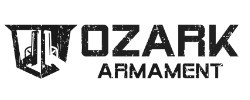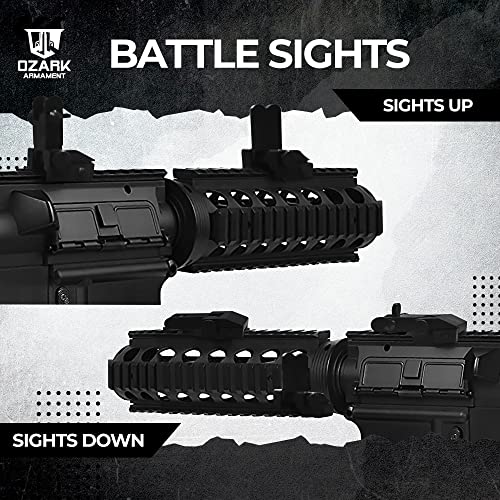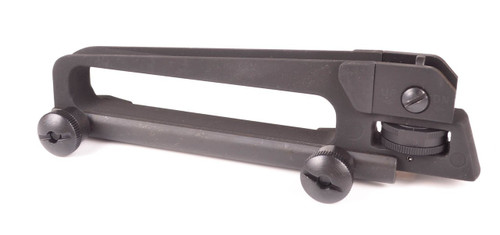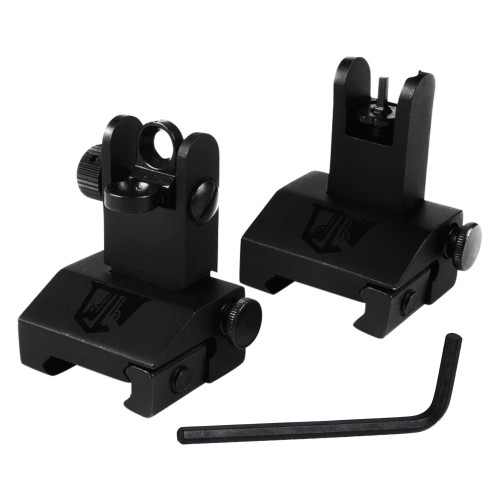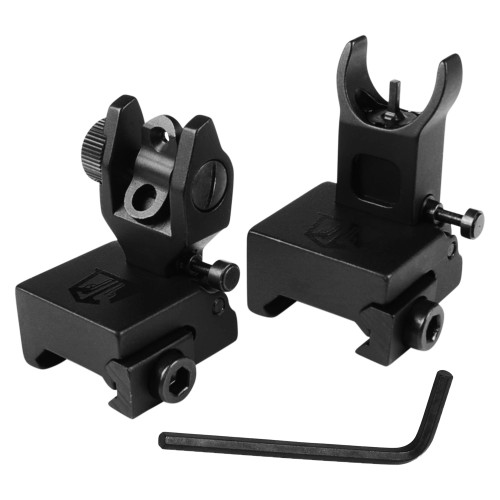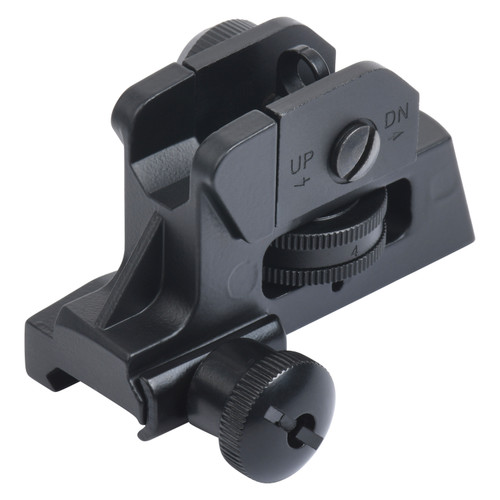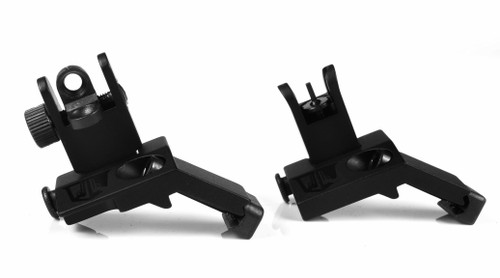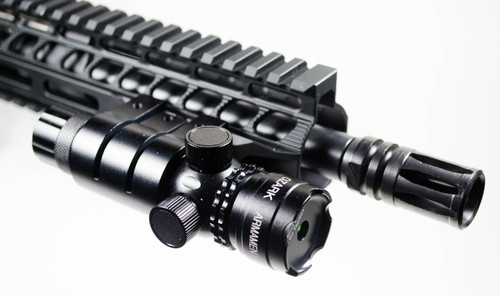Posted by Matt Rice on Jan 23rd 2024
Top Low Profile Iron Sights for AR-15: Must-Haves for Marksmen
Top Low Profile Iron Sights for AR-15: Must-Haves for Marksmen
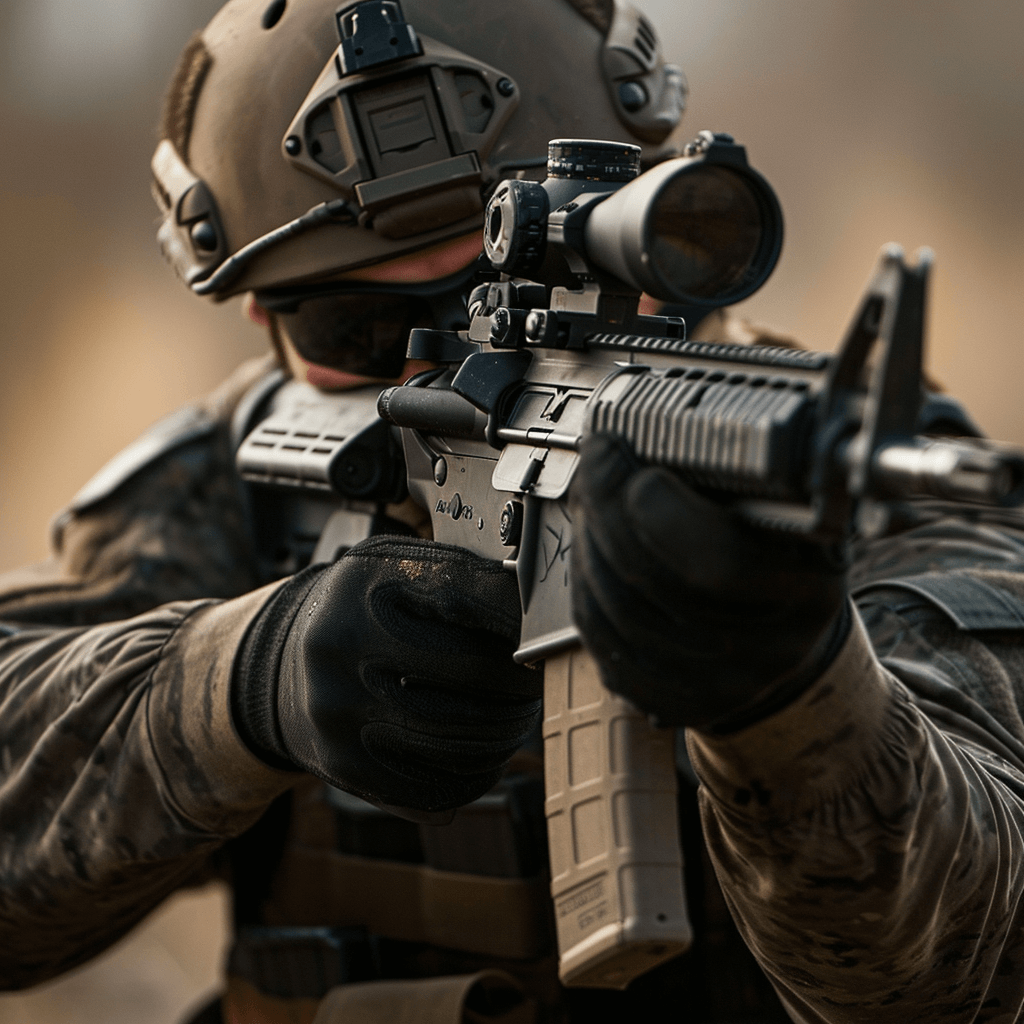
When it comes to customizing your AR-15, choosing the right iron sights is crucial for both form and function. Low profile iron sights are the go-to for shooters looking for a sleek, unobtrusive sighting system that won't get snagged on gear. Precision machined from durable materials like aircraft-grade aluminum, these sights are built to last and offer quick deployment when you need it most.
Whether you're considering the Leapers UTG with its dual aiming aperture or the robust Magpul MBUS Gen 2, low profile iron sights provide reliability without sacrificing the aesthetic of your rifle. They're perfect as a primary sight or as a backup for your optical system, ensuring you're always on target.
Benefits of Low Profile Iron Sights for AR-15
When I'm out at the range or in the field, low profile iron sights for AR-15 are my go-to for a streamlined setup. They minimize snagging, and because they sit close to the barrel, they maintain the sleek profile of my firearm. I've found that low profile iron sights are especially beneficial for those who run a minimalist setup or need to preserve the lightweight nature of their AR-15.
The benefits of including low profile flip up iron sights in my setup can't be overstated. These sights fold down when not in use, ensuring that they won't interfere with my primary optics or get caught as I maneuver through brush or an urban environment. I value the fact that they're there when I need them, flipping up instantly. This quick transition keeps me on target without losing precious seconds, which is crucial in both competitive shooting and tactical scenarios.
With low profile AR iron sights, durability is key. Many options on the market, including ours at Ozark Armament, are crafted from sturdy materials like aircraft-grade aluminum. This choice of material gives me confidence that my sights can withstand the rigors of constant use and exposure to harsh conditions. The UTG iron sights in my collection offer a Posi-Lock Design that ensures they stay put once zeroed in. This feature is critical for maintaining accuracy shot after shot, and it's something I always look for in low profile iron sights AR15 configurations.
Another point worth noting is that low-profile sights often come equipped with dual apertures, catering to both close-quarter and long-range shooting. The versatility of these sights makes them a smart choice for AR-15 owners. Whether it's the wider aperture for a quick sight picture up close or the smaller hole for precision at a distance, having options is always an advantage.
Here's a quick-glance at some of the pros and cons of these sights:
| Pros | Cons |
|---|---|
| Sleek, unobtrusive design | Potential for surface scratches |
| Durable aircraft-grade aluminum | Front sight tool may be required |
| Posi-Lock Design maintains zero | |
| Quick deployment |
Factors to Consider When Choosing Low Profile Iron Sights
When I'm in the market for low profile iron sights for an AR-15, there are a few key factors that I keep in mind to ensure I'm making the best decision for my needs. It's not just about the aesthetic appeal; durability, compatibility, and sight picture are at the top of my list.
First up is the material. Most iron sights, including the popular UTG iron sights, are made of aluminum for its balance of lightweight and sturdiness. When looking at low profile iron sights, it's important in my experience to choose ones made from aircraft-grade aluminum, which stands up to the wear and tear of regular use. The Posi-Lock Design, as seen in some UTG models, adds to the reliability by securing the sight firmly to prevent it from wobbling or losing zero.
Another aspect is the method of operation. Flip-up iron sights are great for a clean, streamlined setup. They can be folded down to stay out of the way of primary optics. However, they contain more moving parts compared to fixed sights, so checking the build and hinge mechanism quality is a must. Conversely, fixed sights such as barrel mounted iron sights or LWRC iron sights are ultra-durable due to fewer moving parts, but they can't be collapsed when not in use.
Let's talk about ease of use: Low profile iron sights should be simple to adjust and zero. You don't want to be fiddling with complicated mechanisms while on the range or in the field. Though my UTG sights did not come with an adjustment tool, I already had one handy. It's something to keep in mind when you're budgeting for your setup.
The sight picture is also essential. A clear view through the sights is non-negotiable. Dual apertures are a common feature of low profile sights, offering versatility for both close-quarters and long-range engagements. Make sure the picture is crisp and that the sights align well with your shooting style.
Top Low Profile Iron Sights for AR-15
As I continue to explore the options available for AR-15 enhancement, it's critical to highlight some of the best low profile iron sights on the market. These sights are not only practical for their intended use but also serve as reliable tools for improved accuracy and performance.
The low profile iron sights for AR-15 are designed to be unobtrusive yet effective. Durability and precision are at the forefront of these designs, ensuring that they withstand the rigors of frequent use. The UTG iron sights come to mind, as they're precision machined from aircraft-grade aluminum. This material choice guarantees resilience and longevity, which is exactly what I look for in iron sights.
When it comes to low profile flip up iron sights, it's hard to overlook the convenience they add to the setup. They're there when you need them and out of the way when you don't. Specifically, the Leapers UTG Model 4 offers an impressive balance between a streamlined profile and accessible usability. It clamps easily onto a top Picatinny rail, ready for quick deployment.
Another contender worth mentioning is the MAGPUL MBUS Gen 2 sights. These sights feature a dual aperture design that's highly adaptable to different lighting conditions and shooting requirements. Especially as a backup sighting system, their windage-adjustable rear sight integrates well with most Picatinny rail systems, marking them as versatile and reliable for shooters who expect adaptability.
The use of T6 6061 anodized aircraft grade aluminum in sights like the Tacfire Same Plane Flip-Up Iron Sights emphasizes a commitment to strength and resilience. An adjustable A2 post adds to the ease of target acquisition, ensuring that precision isn't sacrificed.
For AR-15 owners who value a combination of quality and affordability, here at Ozark Armament we recommend our low profile iron sights for AR-15 that are easy to adjust and exceptionally solid in their build. The user-friendly nature of these sights makes them a strong candidate for those looking to enhance their shooting experience without breaking the bank.
In my search for optimal AR-15 upgrades, it's evident that the selection of low profile iron sights is plentiful. Each option presents its unique set of features tailored to fit various shooting styles and preferences, ensuring that there's a fit for every enthusiast.
Installing and Zeroing Low Profile Iron Sights
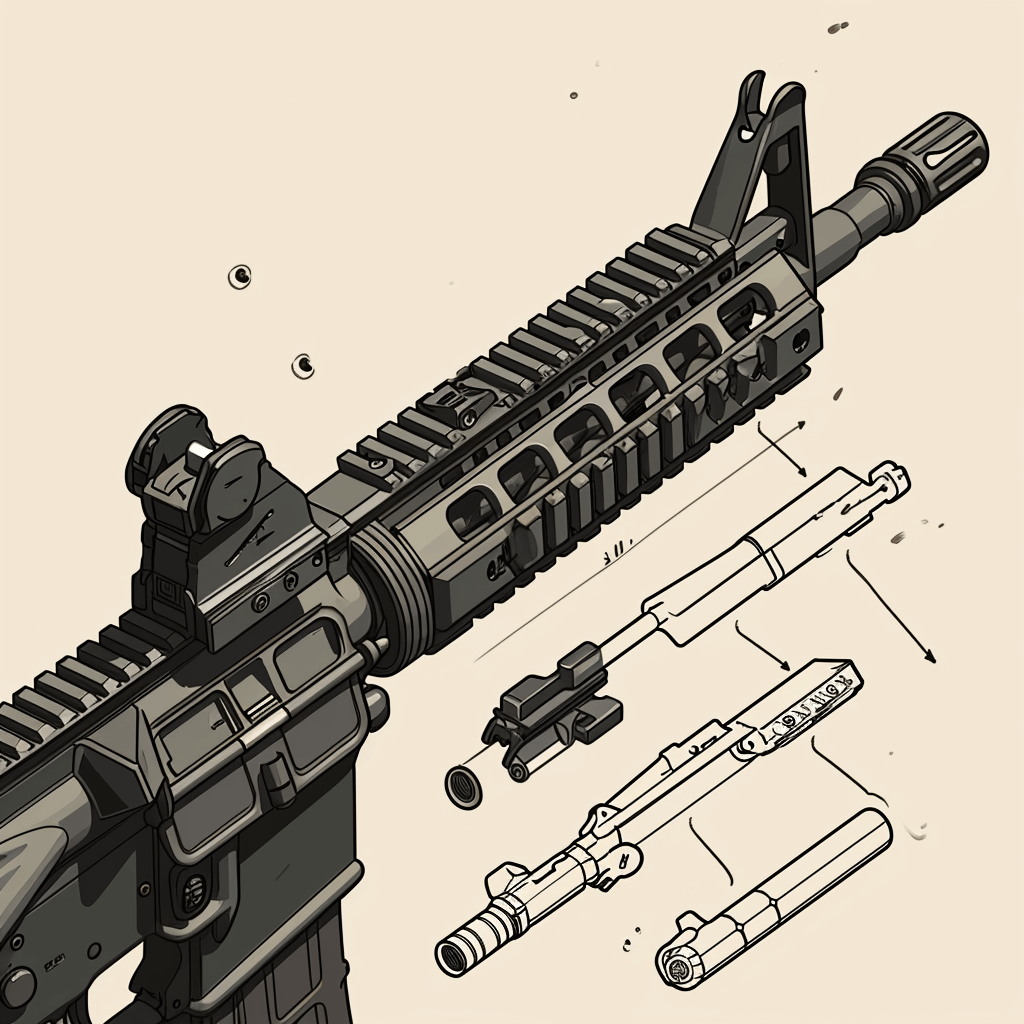
When I'm setting up low profile iron sights for an AR-15, I prioritize consistency and accuracy. Typically, I'll start with the rear sight, ensuring it's perfectly aligned on the rail. Most low profile flip up iron sights come with the necessary installation tools like Allen wrenches. For instance, UTG low profile sights provide a mounting Allen wrench, aiding in a secure fit.
After installing the sights, the next step is zeroing. I've found that barrel-mounted iron sights can sometimes run out of adjustments before hitting zero. It's important to have a front sight tool, as most low profile iron sights, like the Tacticon Armament sights, don't include one. Based on my experience, using the round's casing as an improvised tool can work, but having the actual front sight adjustment tool is always preferable.
Zeroing low profile AR iron sights can be a bit of trial and error if you're not familiar with the process. Since MOA values for sight adjustments aren't universal, it sometimes feels like I'm chasing my shots. This is where live fire tests prove vital. I aim for tight groupings and adjust accordingly, ensuring my zero is precise. It's essential to remember that even with calculated adjustments, verifying your zero with a few rounds downrange is the only way to be certain.
In terms of holding zero, I value sights that maintain their alignment through various conditions. I feel our Ozark low profile iron sights deliver in this aspect, providing reliable performance that doesn't falter after repeated use. They're simplified but sturdy, providing confidence without the need for constant readjustment.
Using Low Profile Iron Sights as Primary or Backup Sights
As an AR-15 owner, I can't stress enough the value of versatility in your sighting options. Whether you're setting up a new rifle or upgrading your trusty firearm, choosing the right sights is crucial. Low profile iron sights provide flexibility, allowing shooters like me to use them as either primary or as backup sights to optics. The right low profile iron sights blend functionality with a minimalist design, ensuring they don't snag on gear or disrupt your shooting experience.
Many shooters prefer low profile iron sights because they are less obtrusive and can be used with ease under various shooting conditions. If you're in the market for low profile flip up iron sights, you'll want to consider options that offer a robust build while maintaining ease of deployment. For example, Ozark Armament sights are favored for their solid construction and quick deployment, qualities that are invaluable whether you're out in the field or at the range.
When looking specifically for low profile iron sights for AR-15, ensure that they are compatible with your rail system. Most AR-15s are equipped with Picatinny rails, and sights like the UTG iron sights are designed to mount seamlessly on these. They offer the added advantage of being lightweight due to their precision-machined construction from materials like aircraft-grade aluminum.
For those who might use optics predominantly, having low profile ar iron sights can serve as a dependable backup. In a situation where your optic fails or gets damaged, flip-up sights, such as the LWRC iron sights or the low-profile BUIS options by Ozark Armament, can be a game-changer. It's all about reliability, and having a set of sights that you can deploy swiftly under pressure enhances your shooting capabilities significantly.
Attachments like barrel-mounted iron sights are less common in low profile configurations, but you can find compact designs that provide the same low-visibility advantage. Regardless of your choice, it's essential that these sights maintain zero once adjusted, minimizing the need to re-zero after every use. This is one area where investing in quality products pays off, as you don't want to second-guess your point of impact when it matters most.
Wrapping up
Choosing the right low profile iron sights for your AR-15 can make all the difference in your shooting experience. I've explored various options that offer durability and quick deployment, essential for both casual shooters and tactical operators. Remember, a sight that maintains zero is crucial for consistent performance. Investing in a quality set, whether you prefer the ruggedness of LWRC or the no frill designs from Ozark Armament, ensures your rifle is equipped for any scenario. Don't overlook the importance of backup iron sights even if optics are your go-to.
Got questions or just want to drop me a line? Send me a note at support@ozarkarmament.com
ARTICLE WRITTEN BY MATT RICE, OWNER OPERATOR OF OZARK ARMAMENT
Frequently Asked Questions
What to Look for in the Best Iron Sights for AR-15?
Durability, compatibility with a red dot sight, ease of use, and a price point that fits your budget are key factors. Consider the material, sight radius, and whether the sights are fixed or flip-up. Usability in a variety of conditions is also important.
What Are Good Iron Sights for AR-15?
Popular options include Magpul MBUS Pro and brands like TROY, Leapers UTG, FAB Defense, Midwest Industries and humbly, Ozark Armament. Research and find a set that meets your specific needs, whether for backup or primary use.
Do You Need Iron Sights on an AR?
While not mandatory, iron sights are recommended as a reliable backup for co-witness setups or for training purposes. They provide an alternative aiming point if electronic optics fail or for close-quarter scenarios.
Are Iron Sights Obsolete?
No, iron sights aren't obsolete. Electronics can fail, but iron sights remain reliable. Many modern rifles are compatible with iron sights, which can be added to Picatinny rails, maintaining their relevancy and usefulness.
Are Iron Sights Good on an AR?
Yes, iron sights are beneficial for an AR, providing a fail-safe aiming option and added flexibility. A quality set of iron sights is useful for situations where optics may not be ideal, such as close-range encounters.
